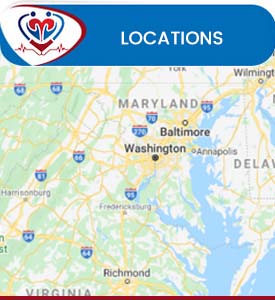Sprains and Strains Treatment Specialist in Alexandria and Ruther Glen, VA
Sprains and strains can happen to anyone. If you are experiencing pain, inflammation, or difficulty in moving the injured body part, you can visit PACS Urgent Care and benefit from our wide variety of services. Some common symptoms of sprains and strains include swelling, pain, tenderness, bruising, and joint pain or muscle pain. Consult Dr. Khaled Said MD and Dr. Walid Hammad for proper diagnosis and treatment. For more information, contact us today or online check-in. We have convenient locations to serve you in Alexandria VA, and Ruther Glen VA.




Table of Contents:
How do sprains and strains happen?
What are the symptoms of sprains or strains?
How can I prevent sprains or strains?
When to see a doctor for sprains or strains?
Strains and sprains are two common injuries that can occur during physical activity. Strains occur when the tendons or muscles are pulled too tightly against one another, while sprains occur when the ligament is stretched beyond its normal range. The most common strains are the hamstring, quadriceps, and patellar tendon. Hamstring strains most often occur when someone squats or lunges; Quadriceps strains usually happen when someone runs, jumps, or cycles; and Patellar tendon strains can be caused by any activity that involves jumping or landing with the knee bent.
Many sports put you at risk for sprains and strains, including:
• Football
• Basketball
• Gymnastics
• Volleyball
These injuries can also occur with everyday activities, such as:
• Slipping on ice
• Falling on your wrist
• Jamming a finger
• Repetitive activities
You can end up with a sprain or strain from any activity that goes beyond your personal physical limits, even from simple activities like walking or swimming. If your connective tissues are tight or your muscles are weak, a simple activity like picking up something heavy or overextending your ankle may cause an injury that could prevent you from taking part in physical exercise for a few weeks.
Tendon and ligament tears are often caused by abnormal movement, especially when there is a heavy load on the tissue, such as an awkward landing after a jump, or rolling an ankle when carrying something heavy. They are also possible due to:
• Falls
• Sudden impact, especially while fully stretched
• Abrupt movement
• Quickly stopping or starting
• Sudden twisting motion
Some illnesses can cause tendons to become weak, which makes them more likely to tear, including the following:
• Kidney disease
• Hyperparathyroidism
• Gout
• Leukemia
• Rheumatoid arthritis
• Diabetes
Long periods of inactivity, such as during recovery, can also make muscles and tendons weaken and stiffen, which makes tears more likely; therefore, it is imperative to perform the proper warm-up exercises and stretches when continuing a physical exercise regimen after a period of inactivity.
Sprains and strains have some symptoms in common and others that are unique to each injury; some of the symptoms they share include:
• Pain
• Swelling/inflammation
• Difficulty moving the injured part
• Limited range of motion
Symptoms vary with the intensity of the injury, but regardless of severity, sprains generally cause bruising. When a sprain first happens, you may feel a tear or pop in the joint; joint function varies with the severity of the sprain.
Characteristics of sprains include:
• If a mild sprain occurs, the ligament is stretched, but the joint is still stable.
• A moderate sprain causes a partial tear in the ligament, making the joint unstable.
• Severe sprains can result in the ligament is completely torn or separated from the bone; if this occurs, the joint is loosened and function is severely impaired.
Some of the most commonly injured ligaments occur in the joints of the limbs, including the ankles, knees, and wrists.
Strains do not cause bruising. Instead, you may experience:
• Muscle spasm
• Muscle weakness
• Cramping
A mild strain involves slight stretching/pulling. A moderate strain includes slight tears. Severe strains involve tears to the muscle, tendon, or both; more serious injuries mean a greater loss of muscle function. Common strain locations are the hamstring, shoulder, neck, and lower back.
You can help to prevent sprains and/or strains by:
• Exercising consistently to maintain strength
• Warming up and stretching before sports
• Avoiding exercise when tired or in pain
• Eating a well-balanced diet to keep muscles strong
• Being aware of falling hazards (dark stairways, uneven sidewalks, toys on the floor)
• Keeping shoes in good shape (fitting well / not worn out)
• Wearing protective equipment or braces during sports
Consult a doctor immediately for a sprain or strain injury if:
• You hear or feel a pop (from tearing of the muscle) at the time of injury
• There is severe pain, swelling, or discoloration in the injured area
• The pain is so severe that you are unable to continue your daily routine
• The pain is present together with other symptoms like fever, chills, pain while urinating, tingling in a leg, the problem controlling bowel or bladder movement
If you or someone you love is suffering from a strain or sprain, come to PACS Urgent Care today for professional care. Contact us today to book an appointment with our sprains and strains treatment specialist, or visit one of our two Virginia clinics; We have convenient locations to serve you in Alexandria VA, and Ruther Glen VA. We look forward to serving you. We serve patients from Alexandria VA, Huntington VA, Arlington VA, Ruther Glen VA, Bagdad VA, Athens VA, Doswell VA, and surrounding areas.
Check Out Our 5 Star Reviews





